| C H A P T E R 3 |
|
Creating IM and IME Volumes |
This chapter explains how to create Integrated Mirroring (IM) and Integrated Mirroring Enhanced (IME) volumes using the LSI SAS BIOS Configuration Utility (SAS BIOS CU). The chapter includes these topics:
You can use the SAS BIOS CU to create one or two IM/IME volumes on each LSI SAS controller, with one or two optional global hot-spare disks. All disks in an IM/IME volume must be connected to the same LSI SAS controller.
Although you can use disks of different size in IM and IME volumes, the smallest disk in the volume will determine the logical size of all disks in the volume. In other words, the excess space of the larger member disk(s) will not be used. For example, if you create an IME volume with two 100 Gbyte disks and two 120 Gbyte disks, only 100 Gbytes of the larger disks will be used for the volume.
Refer to IM and IME Features for more information about Integrated Mirroring volumes.
The SAS BIOS CU is part of the Fusion-MPT BIOS. When the BIOS loads during boot and you see the message about the LSI Configuration Utility, press Ctrl-C to start the CU.

After you press Ctrl-C, the message changes to:
Please wait, invoking SAS Configuration Utility...
After a brief pause, the main menu (Adapter List Screen) of the SAS BIOS CU appears. On some systems, however, the following message appears next:
LSI Configuration Utility will load following initialization!
In this case, the SAS BIOS CU will load after the system has completed its POST. This is an example of the main menu of the SAS BIOS CU.
You can configure one or two IM or IME volumes per Fusion-MPT controller. You can also configure one IM/IME and one Integrated Striping (IS) volume on the same controller, up to a maximum of twelve physical disk drives for the two volumes. In addition, you can create one or two hot-spares for the IM/IME array(s).
The following guidelines also apply when creating an IM or IME volume:
| Note - If a disk in an IM/IME volume fails, it is rebuilt on the global hot-spare if one is available. LSI recommends that you always use hot-spares with IM/IME volumes. |
|
When you enter the SAS BIOS CU, the main menu screen (Adapter List screen) appears.

1. On the Adapter List screen, use the arrow keys to select an LSI SAS adapter (if it is not already selected as it is in the figure above).
2. Press Enter to go to the Adapter Properties screen.
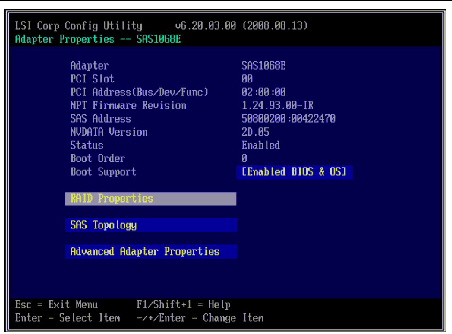
3. On the Adapter Properties screen, use the arrow keys to select RAID Properties on the screen and press Enter.
The Select New Array Type screen appears.
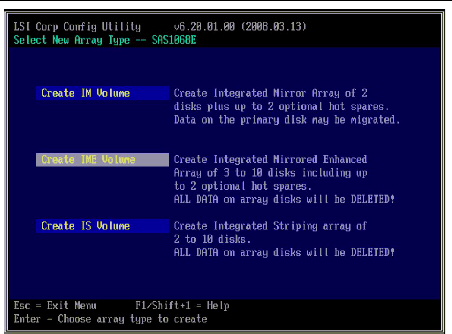
4. When you are prompted to select a volume type, select Create IME Volume.
The Create New Array screen shows a list of disks that can be added to a volume.
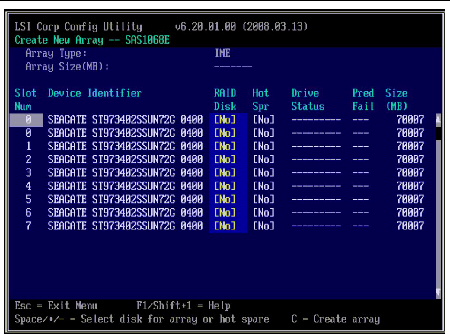
5. Move the cursor to the RAID Disk column and select a disk. To add the disk to the volume, change the No to Yes by pressing the + key, - key, or space bar.
6. Repeat this step to select a total of three to ten disks for the volume.
All existing data on all the disks you select will be overwritten. As you add disks, the Array Size field changes to reflect the size of the new volume.
7. [Optional] Add one or two global hot-spares to the volume by moving the cursor to the Hot Spr column and pressing the + key, - key, or space bar.
When you have finished with Steps 5, 6, and 7, your selections might look like this:
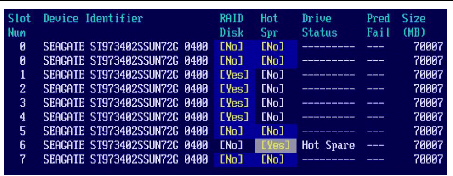
8. When the volume has been fully configured, press C (or c)
A confirmation screen appears.

9. Select Save changes then exit this menu to commit the changes.
The SAS BIOS CU pauses while the array is being created. When the utility finishes creating the array (volume), the main screen reappears.
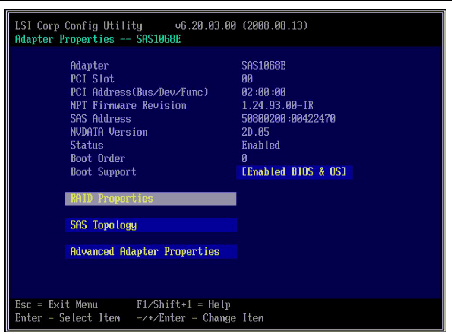
10. Highlight RAID Properties and press Enter.
11. When the next screen appears, select View Existing Array and press Enter.
You see the volume that you have created.

|
| Note - The procedure for creating an IM volume is almost the same as the process for creating an IME volume. In the case of an IM volume, you can only include two disks and you have the option of not erasing the first disk that you choose (see Step 6 in the procedure below). Use the figures in the IME procedure as necessary to visualize the IM procedure. |
1. On the Adapter List screen, use the arrow keys to select an LSI SAS adapter.
2. Press Enter to go to the Adapter Properties screen.
3. On the Adapter Properties screen, use the arrow keys to select RAID Properties on the screen and press Enter.
4. When you are prompted to select a volume type, select Create IM Volume.
The Create New Array screen shows a list of disks available to be added to a volume.
5. Move the cursor to the RAID Disk column and select a disk. To add the disk to the volume, change the No to Yes by pressing the + key, - key, or space bar.
When the first disk is added, the SAS BIOS CU prompts you to either keep existing data or overwrite existing data.
6. Press M to keep the existing data on the first disk or press D to overwrite it.
If you keep the existing data, this is called a data migration. The first disk will be mirrored onto the second disk, so any data you want to keep must be on the first disk selected for the volume. Data on the second disk is overwritten. The first disk must have 512 Kbytes available for metadata after the last partition.
As disks are added the Array Size field changes to reflect the size of the new volume.
7. [Optional] Add one or two global hot-spares by moving the cursor to the Hot Spr column and pressing the + key, - key, or space bar.
8. When the volume has been fully configured, press C, then select Save changes then exit this menu to commit the changes.
The SAS BIOS CU pauses while the array is being created.
The LSI SAS controllers allow you to configure two IM or IME volumes per controller. If one volume is already configured, and if there are available disk drives, you can add a second volume.
|
1. On the Adapter List screen, use the arrow keys to select an LSI SAS adapter.
2. Press Enter to go to the Adapter Properties screen.
3. On the Adapter Properties screen, use the arrow keys to select RAID Properties and press Enter.
4. Continue with Step 4 of To Create an IME Volume or Step 4 of To Create an IM Volume
You can create one or two global hot-spare disks to protect the IM or IME volumes on a SAS controller.
| Note - All hot spares are global, including those that you create when you create a RAID volume. |
Usually, you create global hot-spares at the same time you create the IM/IME volume. Follow these steps to add global hot-spare disks later:
|
When you enter the SAS BIOS CU, the main menu screen (Adapter List screen) appears.
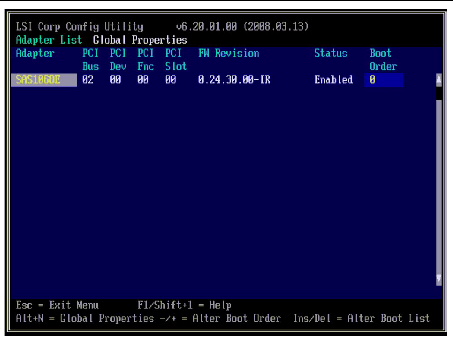
1. On the Adapter List screen, use the arrow keys to select an LSI SAS adapter (if it is not already selected as it is in the figure above).
2. Press Enter to go to the Adapter Properties screen.
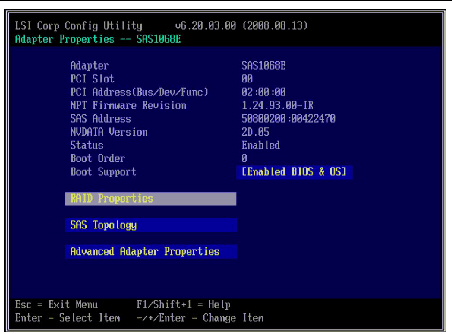
3. On the Adapter Properties screen, use the arrow keys to select RAID Properties on the screen and press Enter.
The Select New Array Type screen appears.
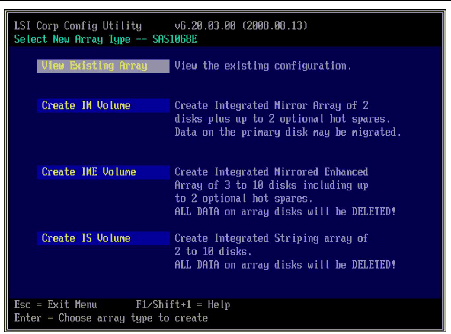
4. On the Select New Array Type screen, select View Existing Array.
The View Array screen appears.
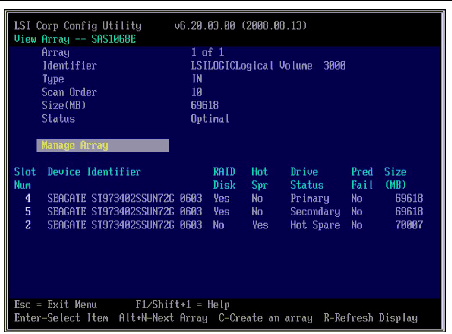
5. Select Manage Array on the View Array screen.
The Manage Array screen opens.

6. Highlight Manage Hot Spares and press Enter.
The Manage Hot Spares screen appears.
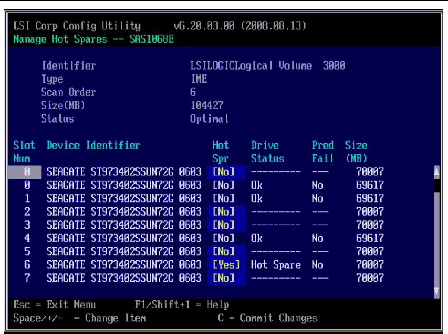
7. Select a disk from the list by pressing the + key, - key, or spacebar.
8. After you select the global hot-spare disk, press C.
An error message appears if the selected disk is not at least as large as the smallest disk used in the IM/IME volume(s). The global hot-spare disk must have 512-byte blocks, it cannot have removable media, and the disk type must be either SATA with extended command set support or SAS with SMART support.
If SATA disks are used for the IM/IME volume(s), the hot-spare disk must also be a SATA disk. If SAS disks are used, the hot-spare disk must also be a SAS disk. An error message appears if the selected disk is not the same type as the disks used in the IM/IME volumes.
9. [Optional] Select a second hot-spare disk.
10. Select Save changes then exit this menu to commit the changes.
The configuration utility pauses while the global hot-spares are being added.
| Note - The hot spares are available for rebuilding any RAID volume, including one that has not yet been created. |
|
1. Select Manage Hot Spare on the Manage Array screen.
2. Select Delete Hot Spare and then press C.
If there are two hot-spares, select which one you want to delete.
3. Select Save changes then exit this menu to commit the changes.
The configuration utility pauses while the global hot-spare is being removed.
This section explains how to perform other configuration and maintenance tasks for IM and IME volumes:
|
1. In the SAS BIOS CU, select an adapter from the Adapter List. Select the RAID Properties option.
The properties of the current volume are displayed. If global hot-spares are defined, they are also listed.
2. If two volumes are configured, press Alt+N to view the other array.
3. To manage the current array, select the Manage Array item and press Enter.
The Synchronize Array command forces the firmware to re-synchronize the data on the mirrored disks in the array. It is seldom necessary to use this command, because the firmware automatically keeps the mirrored data synchronized during normal operation. When you use this command, one disk of the array is placed in the Degraded state until the data on the mirrored disks has been re-synchronized.
1. Select Synchronize Array on the Manage Array screen.
2. Press Y to start the synchronization, or N to cancel it.
An array can become inactive if, for example, it is removed from one controller or computer and moved to another one. The Activate Array option allows you to reactivate an inactive array that has been added to a system. This option is only available when the selected array is currently inactive.
1. Select Activate Array on the Manage Array screen.
2. Press Y to proceed with the activation, or press N to abandon it.
After a pause, the array will become active.

|
Caution - Before deleting an array, be sure to back up all data on the array that you want to keep. |
1. Select Delete Array on the Manage Array screen.
2. Press Y to delete the array.
After a pause, the array is deleted. If there is another remaining array and one or two hot-spare disks, the BIOS checks the hot-spare disks to determine if they are compatible with the remaining array. If they are not compatible (too small or wrong disk type) the firmware deletes them also.
You can use the SAS BIOS CU to locate and identify a specific physical disk drive by blinking the drive’s LED. You can also use the SAS BIOS CU to blink the LEDs of all the disk drives in a RAID volume. There are several ways to do this:
1. When you are creating an IM or IME volume, and a disk drive is set to Yes as part of the volume, the LED on the disk drive is blinking. The LED is turned off when you have finished creating the volume.
2. You can locate individual disk drives from the SAS Topology screen. To do this, move the cursor to the name of the disk in the Device Identifier column and press Enter. The LED on the disk blinks until the next key is pressed.
3. You can locate all the disk drives in a volume by selecting the volume on the SAS Topology screen. The LEDs blink on all disk drives in the volume.
| Note - The LEDs on the disk drives will blink as described above if the firmware is correctly configured and the drives or the disk enclosure supports disk location. |
You can select a boot disk in the SAS Topology screen. This disk is then moved to scan ID 0 on the next boot, and remains at this position. This makes it easier to set BIOS boot device options and to keep the boot device constant during device additions and removals. There can be only one boot disk.
1. In the SAS BIOS CU, select an adapter from the Adapter List.
2. Select the SAS Topology option.
The current topology appears. If the selection of a boot device is supported, the bottom of the screen lists the Alt+B option. This is the key for toggling the boot device. If a device is currently configured as the boot device, the Device Info column on the SAS Topology screen will show the word “Boot.”
3. To select a boot disk, move the cursor to the disk and press Alt+B.
4. To remove the boot designator, move the cursor down to the current boot disk and press Alt+B. This controller will no longer have a disk designated as boot.
5. To change the boot disk, move the cursor to the new boot disk and press Alt+B. The boot designator will move to this disk.
| Note - The firmware must be configured correctly in order for the Alt+B feature to work. |
Copyright © 2006, 2007 by LSI Logic Corporation. All rights reserved. © 2009 Sun Microsystems, Inc. All rights reserved.